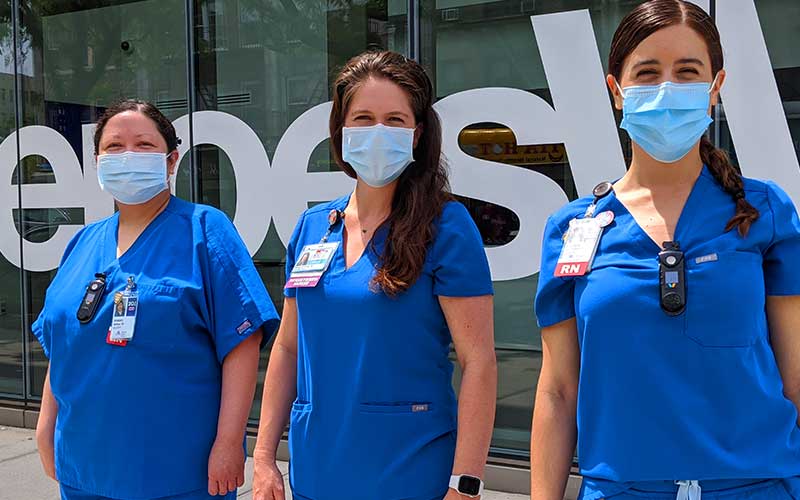What Do I Need to Know About Hotels and Vacation Rentals During the COVID-19 Pandemic?

Much as you may be bored with staying home, the decision to travel during this time is a difficult one. Experts recommend avoiding all non-essential travel. Any travel, says the U.S. Centers for Disease Control and Prevention (CDC), increases your chances of getting and spreading COVID-19. But if you still need—or want—to get away, Mirna Mohanraj, MD, a pulmonologist with the Mount Sinai Health System, answers some of your questions about staying in hotels and vacation rentals like Airbnbs during the pandemic.
Is it safe to travel? How should I decide where to go?
The CDC states that travel increases your chances of getting and spreading COVID-19. You should stay home if you have any COVID-19 symptoms, have been diagnosed with COVID-19, are waiting for COVID-19 test results, or were recently exposed to someone with COVID-19.
There’s never been a better time for a staycation. But, if you do want to travel, talk with your doctor about your personal risk and try to avoid areas that are experiencing an increase in new COVID-19 cases. Also, the CDC provides detailed guidelines on personal precautions to reduce your chances of getting and spreading the virus.
Should I stay at a hotel or a rent an apartment?
Both options may increase your risk of getting and spreading COVID-19. Hotels have the added challenge of high-traffic areas like lobbies, elevators, gyms, restaurants, and other common spaces. For this reason, it may be better to stay at a non-shared facility like an Airbnb. Airbnb has posted its safety guidelines to help travelers and hosts know what to expect. For hotels, safety precautions vary. Be sure to inquire about your specific lodging place before arrival.
How do I pick a safe place to stay?
To find a place that meets your comfort level, do your research in advance. Check the hotel or vacation rental website to see if it is following the guidelines issued by the CDC and the U.S. Environmental Protection Agency (EPA). Also, check that the facility is adhering to any state or local guidelines for cleaning and disinfection. In general, the location should follow special protocols between guests as well as throughout the day. They should be especially careful about disinfecting high contact surfaces like doorknobs, light switches, and elevator panels.
It is also important that the location screens staff daily for COVID-19 symptoms as well as follows guidelines for social distancing and wearing masks/appropriate protective gear. Opt for facilities that have committed to reduced occupancy and contactless check-in/check-out and inquire if there is a minimum vacancy period or ‘booking buffer’ between guest departures (Airbnb recommends 72 hours. This may be based on studies published in The New England Journal of Medicine and The Lancet have shown that the virus can live on hard surfaces for up to three days. So, even if a facility does not perform enhanced cleaning perfectly, this should leave adequate time for the virus to die.). Ask if you can text message hotel services rather than communicate in person during your stay. And, check if the facility has contactless room service as your hotel room is the safest place to eat.
Once you arrive, you may find that your hotel experience is different than what you are used to. Some hotels are sealing guest rooms prior to arrival to show that they are following cleaning protocols. Your room may also be stocked differently and may not contain items that are difficult to disinfect, such as robes and blankets. If your hotel/vacation rental is following all the appropriate guidelines, it should be safe to use whatever materials are in the room.
How can I protect myself?
As with everything else during this pandemic, it is best to be prepared. Bring plenty of face coverings and hand sanitizer. You can’t be sure that your hotel or vacation rental will provide these. Avoid face-to-face encounters whenever possible and wear a face covering as soon as you leave your room. Take the stairs instead of the elevator. Try to avoid any common areas, such as gyms, restaurants, and lobbies, and only use your private bathroom. If you find yourself in a common area, be sure to keep six feet away from everyone outside your travel party.
There should be adequate ventilation—even with air conditioning—so, it’s always good to open windows and/or doors for better air circulation. If you’re concerned about disinfection protocol, you can bring your own cleaning supplies. You may even want to personally wipe down high contact surfaces in your room like remote controls, faucet handles, light switches, hangers, and doorknobs.
Is it safe to visit the hotel’s restaurant?
You might want to decide this in advance. Before you leave home, I recommend checking the hotel restaurant website to review its COVID-19 practices including personal protective gear for hosts and servers.
‘Grab and Go’ stations are safer than a sit-down meal and dining in a distanced open-air location is better than indoor service. But, if you do decide to eat in, avoid buffets, self-serve, and valet parking. Also, ask about safety protocols in advance. Is the restaurant limiting occupancy or making an effort to distance diners? Are digital menus available? Can you order and pay via mobile device?
Is the hotel’s pool safe?
Being in a swimming pool or open water is unlikely to increase your risk of contracting COVID-19 as long as you maintain appropriate personal protective habits: frequent and appropriate handwashing after touching high-contact surfaces, face covering outside the water, and social distancing both in and out of the water.
However, before you enter the pool, inquire about the facility’s safety protocols. Is the location using enhanced cleaning and restricting capacity? Also, ask about the cleaning of shared equipment, such as bicycles and beach chairs, between guests.
If you have any other questions, check out the CDC website for full guidelines on travelling during the COVID-19 pandemic.












